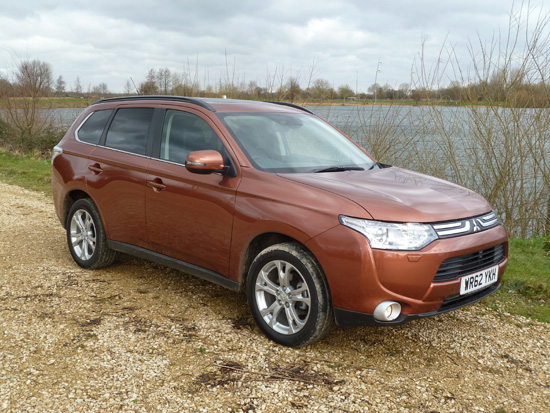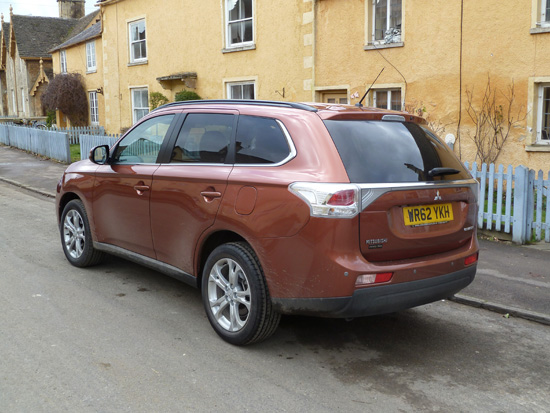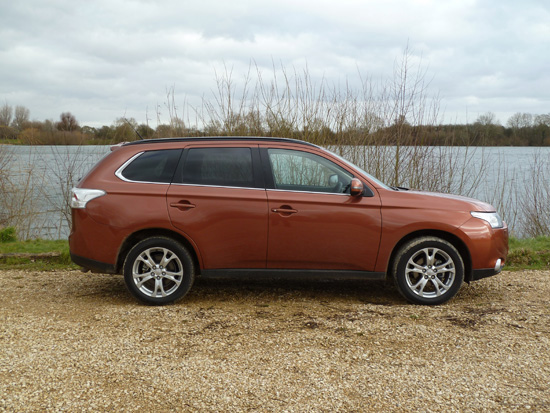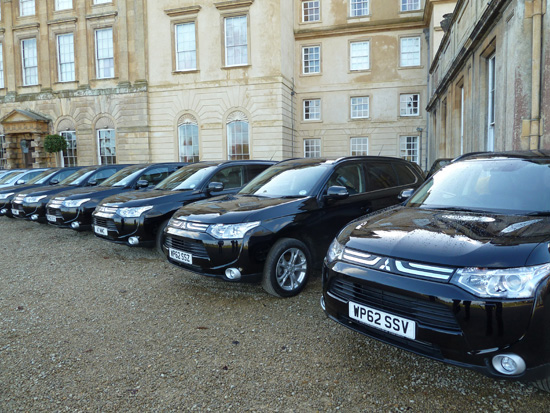 Kim Henson samples the latest SUV from Mitsubishi…
Kim Henson samples the latest SUV from Mitsubishi…
Since 2001, Mitsubishi has sold 950,000 Outlanders around the world, and the version introduced in Britain in 2007 has proved to be a popular machine with buyers here. I drove this model at its launch, and I was impressed then by its road manners, practicality and overall competence.
Six years down the line, and Mitsubishi has upped the game again. Managing Director of Mitsubishi Motors UK, Lance Bradley, introduced the new model to motoring writers by saying, “We are proud to call this vehicle an SUV”. Now that’s quite a statement, and very important, as four wheel drive vehicles in general have suffered (often unfairly) from some negative press in recent times.
Some commentators – often with little or no factual evidence on which to base their assumptions – have tarred all wheel drive vehicles with the same, dark-coloured brush, especially with regard to the vehicles’ environmental credentials.
The fact is that during the last few years, manufacturers have been steadily cleaning up their acts with their four wheel drive models. Indeed the 2007 Outlander was one of the first of the ‘greener’ MPVs, notably having ‘best in class’ emissions performance, and this model helped to change Mitsubishi’s image.
NEW OUTLANDER
Enter the 2013 Outlander. Based on the platform of the Lancer (with EVO 10 technologies applied), it’s been re-engineered from top to bottom, and is claimed to provide a class-leading environmental performance.
For a start it incorporates much high tensile steel, and, by comparison with the outgoing model, has lost weight. Tipping the scales at just 1,555 kg (3,428 lb), it is said to be lighter than a 1 Series BMW, and less than half as heavy as an Audi Q7.
Aerodynamic aspects have been addressed too. For example, the ‘A’ posts (front windscreen pillars) have been ‘smoothed’, and the size of the front air intake grille has been minimised. In addition, an aerodynamic air shield has been installed beneath the engine. Another small but useful improvement to air flow has been made by fitting ‘hidden’ windscreen washer jets.
The combined effect of the myriad of changes is that there has been a seven per cent reduction in aerodynamic drag, so that the coefficient of drag for the latest Outlander is just Cd 0.33 (or the same as a Nissan Micra).
An economical driving style, producing minimal emissions, is encouraged too by an ‘Eco’ drive system, and a dash display which flags up ‘green leaves’ (up to five in number; five is ‘best’). Gimmicks? Not at all; truly, every little helps…
When driving in ‘Eco’ mode, the engine output is suppressed a little so that the rate of acceleration is more gentle than when using the ‘normal’ set-up. In addition, the default ‘auto’ drive setting is ‘Eco four wheel drive’ mode. This means that in normal motoring the vehicle is being driven by the front wheels, but when road situations demand more, a series of sensors tell the control unit to bring the rear wheels into the equation as well; the percentage split between front and rear wheel drive varies according to circumstances, but can be up to 50/50.
The latest four wheel drive set-up combines an Electronic Control Coupling with the Electronic Control Unit that controls it. A yaw rate sensor is incorporated, and this accurately assesses the vehicle’s cornering movements, this information being used by the system to provide sharper steering response.
CHEAPER TO RUN
The class leading CO2 emissions count of 140 g/km for manual transmission versions results in a relatively low Band ‘E’ road tax rating, which works out at £120 per year (for both of the first two years from new). By contrast the automatics (with a six speed ‘Intelligent’ ‘INVECS II” six speed gearbox that senses, and responds/adapts to, driving style), produce a CO2 emissions count of 153 g/km, which is still far lower than rivals from other makers, and means that the new car qualifies for a road tax rate of £170 per annum, for the first and second years of ownership from new.
With taxes in general, and road tax in particular, being a sensitive issue for buyers, this is important.
To put all this in perspective, it is astonishing that the Outlander, a roomy, seven seater 4×4, is in the same road tax band as a 1.4 litre VW Polo…
On paper, the fuel consumption figures look good too, with the aluminium, 2.2 litre four cylinder Di-D turbo diesel engine (177 PS in two wheel drive form; 150 PS in four wheel drive guise) having ‘Combined’ consumption figures of 52.3 mpg for manual versions, with the automatics giving 48.7 mpg.
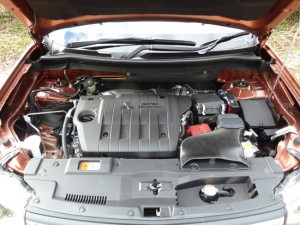
The proven but improved power unit is a common rail, direct injection motor, running with a very low (for a diesel) compression ratio of just 14.9:1. This ‘low impact’ Euro 5 compliant engine now produces more torque at low engine speeds; its maximum of 380 Nm (280 lb.ft) is delivered all the way from 1,750 to 2,500 rpm. Performance is aided by the impressive aerodynamics, so in manual transmission form the Outlander is capable of scooting from rest to 62 mph in 10.2 seconds, and has a top speed potential of 125 mph. Acceleration from the automatic versions is a little slower, taking 11.7 seconds for the zero to 62 mph dash.
HIGH SPEC
The model designations for the new Outlanders start at GX1 and rise to GX5. It is interesting to note that the GX1 is a ‘commercial’ version, yet still provides a reasonable level of factory-fitted equipment. In addition, it provides a payload of 705 kg (1,554 lb) – up from the 520 kg (1,146 lb) of the outgoing model, and better than (say) a Ford Transit Connect and many other commercial vans.
Mitsubishi engineers have worked hard to improve the soundproofing of the new Outlanders, by looking at every area around the car and giving occupants an even quieter and more refined drive than in the outgoing models.
Seven seats come as standard in the GX3 and higher specification models, and in the new cars, the third (rearmost) row of seats is now divided on a 50/50 basis, aiding practicality in everyday use.
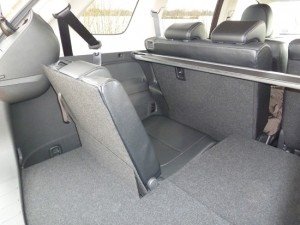
Mitsubishi has paid attention to detail in the load compartment, for example ensuring that the seats are easy to fold, and that the load area is flat-floored when the seats are folded. It is also the longest in its class, at 1,741 metres (nearly 5ft. 9in).
Specific equipment varies according to version, but among the many features found on the new range are seven airbags (all passenger models), high definition satellite navigation (GX4 and GX5), and keyless entry/push-button start system (GX4 and GX5).
The range-topping GX5 – offered only with automatic transmission – features as standard a power-operated tailgate, a DAB sound system, radar-based Adaptive Cruise Control and a ‘Forward Collision Mitigation’ system (it doesn’t eradicate the risk of a frontal collision, but helps the driver to avoid one, and ultimately applies the brakes if required).
On the GX5 there’s also a ‘Lane Departure Warning’ system, which is especially helpful on main roads and motorways (it can be de-activated for driving in town and on country lanes).
The towing capacity of the new Outlander is an impressive 2,000 kg (4,409 lb) – sufficient to accommodate a horsebox or a sizeable caravan.
Safety aspects have been addressed throughout the vehicle, resulting in a Euro NCAP rating of Five Stars.
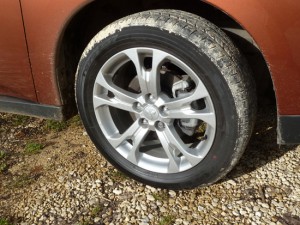
At the time of writing (February 2013), the price of the GX1 had not yet been decided, However, the GX2 is priced at £23, 699, the GX3, £26,399, GX4, 31,399 and GX5, £33,399.
Income tax bills for company drivers who choose a new Outlander are said to have been lowered significantly compared with the outgoing vehicle, and rival models.
DRIVING IMPRESSIONS
Over an 80 mile route I was able to put the new Outlander, in range-topping GX5 form, through its paces.
For the majority of my time with the vehicle it was set to ‘Eco’ mode, which provided adequate acceleration and excellent hill-climbing ability. A quick change out of ‘Eco’ mode changed the parameters of the control systems, giving the performance extra ‘edge’ when required.
The engine delivered its torque strongly from low speeds, and high overall gearing resulted in a cruising speed of 60 mph requiring just 1,600 rpm.
On the six speed automatic version I drove (a six speed manual model is also available), steering column-mounted ‘paddle’ controls enable manual gearchanging to be carried out when required. A quick touch on both paddles instantly brings the transmission back into fully automatic operating mode.
I was very impressed by the hushed progress of the vehicle, which felt smooth and refined, as well as simply ‘quiet’, even when accelerating hard. This bodes well for owners who frequently drive long distances.
The seats were accommodating, and ride comfort provided by the test car was reassuringly firm but not uncomfortable. Handling felt safe, even on twisting routes.
I was able to try out the Adaptive Cruise Control and Lane Departure Warning systems, both of which worked well – although like any cruise control of its type, it takes a while to familiarise oneself with how it is set up, and how it can be adjusted to suit your own preferences.
The Outlander is spacious throughout, and even in the third row of seats, which when out of use fold flush with the load compartment floor, passengers should find adequate head and leg room.
Stowage space is good, with (for example), deep, long front door bins incorporating bottle holders, plus two further cup/bottle holders in the centre console.
The luggage compartment is roomy and, usefully, flat-floored. Beneath the rearmost edge of the floor there’s a handy compartment for storage of items that you don’t want rolling around loose in the boot.
Fuel consumption? To be honest I was a little disappointed that the average consumption during my test drive, most of which was undertaken at moderate speeds in ‘Eco’ mode, was displayed by the on-board computer as being just 33.8 miles per gallon – some way off the official 48.7 mpg ‘Combined’ figure, which was more in the area I was expecting. In fairness the test vehicle had not covered many miles, so consumption might improve in time.
VERDICT
Very impressive. Capable, refined, practical, good to drive and likeable, the Outlander should prove popular with buyers seeking an SUV to fulfil a range of family needs.
In due course we hope to bring you a full road test, based on a longer time with the car.
COMING SOON…
Arriving in the U.K. in the summer of 2013 is the ‘Plug-in Hybrid Electric Vehicle’ (‘PHEV’) version of the Outlander. Introduced at the Paris Motor Show in 2012, and already on sale in Japan, where it has proved to be very popular, this model features ‘High Tech Series Parallel’ hybrid technology.
In plain English this translates into an SUV that is capable of travelling over 30 miles and at speeds of over 60 mph, in ‘electric’ drive mode, and which also has a petrol motor to use when required, so that the total driving range is around 550 miles. It is estimated that its overall ‘equivalent’ fuel consumption will work out at 147.9 miles per gallon, and CO2 emissions at just 44 g/km.
The price is yet to be announced, but Mitsubishi assured me that it would be ‘competitive’.
WHEELS-ALIVE TECH. SPEC. IN BRIEF
MITSUBISHI OUTLANDER 2.2 D-iD GX5 Auto
Engine: ‘4N1’ 2268cc 16 valve four cylinder, twin overhead camshaft
Power: 4WD: 150 PS @ 3,500 rpm
Torque: 4WD: 380 Nm (280 lb.ft) @ 1,750 to 2,500 rpm
0-62 mph: 4WD: 11.7 sec
Top speed: 125 mph
Fuel consumption: (‘Urban’): 39.8 mpg
(‘Extra Urban’): 55.4 mpg
(‘Combined’): 48.7 mpg
CO2 emissions: 153 g/km
‘On the road’ price £33,399.
